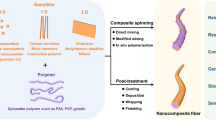Abstract
A new method for producing glass of greater than equilibrium thickness has been developed, whose main principle consists in developing a compressive force along the glass band axis using several pairs of edge-restricting machines. Application of this method makes it possible to produce high-quality thickened glass 1700 – 1800 mm wide, to lower losses by shortening the time of transition from one glass thickness to another, and to avoid a decrease in the machine efficiency when making thicker glass.
Similar content being viewed by others
REFERENCES
V. I. Kondrashov and V. S. Bezlyudnaya, “Methods for producing float glass of greater than equilibrium thickness,” Steklo Keram., No. 3, 3–8 (1999).
N. A. Shaeffer and K. H. Hausner, Technology of Glass [Russian translation], Kishinev (1998).
V. Ya. Matveenko and T. A. Egorova, “Determination of glass band thickness in a tank with tin melt at various stages of molding,” Steklo Keram., No. 5, 13–14 (2002).
Author information
Authors and Affiliations
Rights and permissions
About this article
Cite this article
Egorova, T.A., Matveenko, V.Y., Kondrashov, V.I. et al. Production of Float-Glass of Greater Than Equilibrium Thickness. Glass and Ceramics 59, 365–366 (2002). https://doi.org/10.1023/A:1022567904889
Issue Date:
DOI: https://doi.org/10.1023/A:1022567904889




